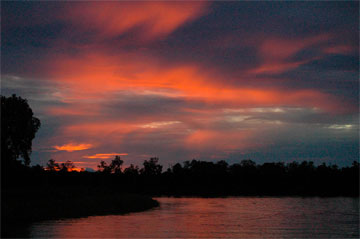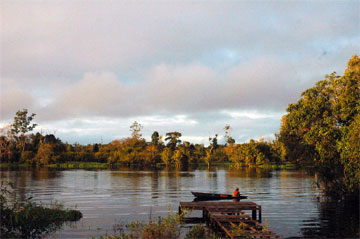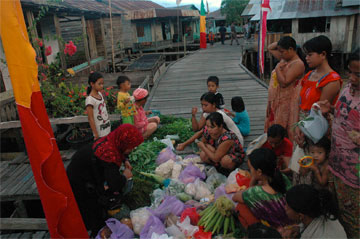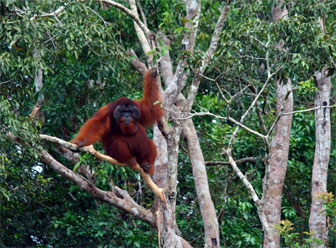When people are hungry for an uncertain income, they will destroy everything. When people become poor due to a poor decision they were excluded from making, who should be responsible for that?
Development is seen as the answer to poverty. However, many controversial developments have actually increased poverty, and while the investors in such schemes may benefit, the local people pay the price.
This happened in Tundai, a fishing village in the ex-mega rice area near Palangkaraya, Central Kalimantan. When central government in the 1990s decided to convert the peat swamp forests into rice fields, the community had no voice or involvement in the decision. The project failed. Now over a million hectares of former lush forests have become a wasteland, and the people of Tundai have been thrust into poverty.
 Tundai sunset. Photo by Yani Saloh |
The wider environmental impacts have become clear over time. The deforested and drained peat swamps easily catch fire in dry years resulting in huge fires and suffocating smog that may linger over the village for months. The haze affects public health and especially young children and the elderly. In dry years over 30% of the children have respiratory disorders because of the resulting smog.
Nobody knows the long-term effects are of many years of breathing – for months on end – the toxic peat smoke. The peat degradation also results in continuous emissions of huge amounts of carbon dioxide (CO2), a greenhouse gas that contributes to global warming. Yet another consequence of the environmental destruction is the decrease in fish productivity in the area’s rivers and streams. This has directly affected the economy and livelihoods of the local people.
The decision to convert the peat swamps into rice fields enabled the rapid harvesting of the valuable timber in the area. Some people got very rich. But the people of Tundai village were left with a degraded environment and increased poverty.
With a new international financing scheme named REDD+ (reducing emissions from deforestation and forest degradation), there is hope that there will be payments for forest restoration and protection. Whereas in the past the conservation of tropical forests was seen as the responsibility of tropical countries alone now – there is international interest to pay substantially for the regeneration and conservation of forests and peatlands.
  Tundai. Photos by Yani Saloh |
Reducing emissions and sequestering carbon has become a new business opportunity. It will be essential, however, that the local communities are involved in these developments from the outset: in planning, decision-making and implementation. These developments will again attract people from the outside. This brings a risk that the carbon projects will fail unless they are developed with, and by, local people, who need compensation for their efforts.
“REDD provides an opportunity for international communities, namely developed countries and companies, to contribute to the solutions of maintaining carbon stocks above and below the ground, while creating new sustainable livelihood opportunities for the locals,” explains Agus Purnomo, Special Staff to the President of Republic Indonesia for Climate Change.
But REDD is complex, and clear mechanisms for international funding to reach the local people and action on the ground are still in their infancy. “I never heard anything about such a thing,” I was told by the local people. “If this mechanism can become reality, we hope that the funding will provide benefits directly to the local people.”
“Grants currently received often go to the ground like an inverted pyramid” said Suwido Limin, head of Center for International Tropical Peat Forest Research (CIMTROP) at the University of Palangkaraya, meaning that while a lot of money goes into the system, only a small percentage of funding is received by local people. “The challenge is how to reverse the pyramid of benefits so the people on the ground will be receiving more than those at the top?”
“The government should ensure that payments will be reaching the right targets,” said Alue Dohong, Kalimantan Site Coordinator of Wetland Indonesia Program.
 Orangutan. Photo by Yani Saloh |
“The management of large areas of degraded peatlands for forest regeneration and emission reductions can create thousands of local jobs,” asserts Marcel Silvius of Wetlands International, a Netherlands-based environmental NGO. “Local communities could become shareholders in carbon credit schemes, thus benefiting from successful projects.” To unlock this potential, national and local governments need to create the necessary regulations and oversee the governance of the projects.
There is a need to balance economic development and conservation of natural resources. The natural resources utilization should according the state laws and be aimed at economic growth for the welfare of the people at large, not just a few. It is time for the local people to be empowered in these exciting and new opportunities for sustainable development. Local wisdom needs to be respected and included into the decision making process for policies that will impact their lives.
Related articles
Indonesia’s plan to save its rainforests

(06/14/2010) Late last year Indonesia made global headlines with a bold pledge to reduce deforestation, which claimed nearly 28 million hectares (108,000 square miles) of forest between 1990 and 2005 and is the source of about 80 percent of the country’s greenhouse gas emissions. President Susilo Bambang Yudhoyono said Indonesia would voluntarily cut emissions 26 percent — and up to 41 percent with sufficient international support — from a projected baseline by 2020. Last month, Indonesia began to finally detail its plan, which includes a two-year moratorium on new forestry concession on rainforest lands and peat swamps and will be supported over the next five years by a one billion dollar contribution by Norway, under the Scandinavian nation’s International Climate and Forests Initiative. In an interview with mongabay.com, Agus Purnomo and Yani Saloh of Indonesia’s National Climate Change Council to the President discussed the new forest program and Norway’s billion dollar commitment.
Communities must benefit for forest carbon schemes to be effective
(12/17/2007) By Rezal Kusumaatmadja and Gabriel Thoumi. Much has been promised by what avoided deforestation (AD) carbon credits can do to support forest protection, increase tax revenues, and develop sustainable rural economies in our Zamrud Khatulistiwa — Emerald on the Equator. In the wake up of the COP 13 meeting in Bali, the focus of media attention has been on how much money rainforest countries can receive for protecting their forests.